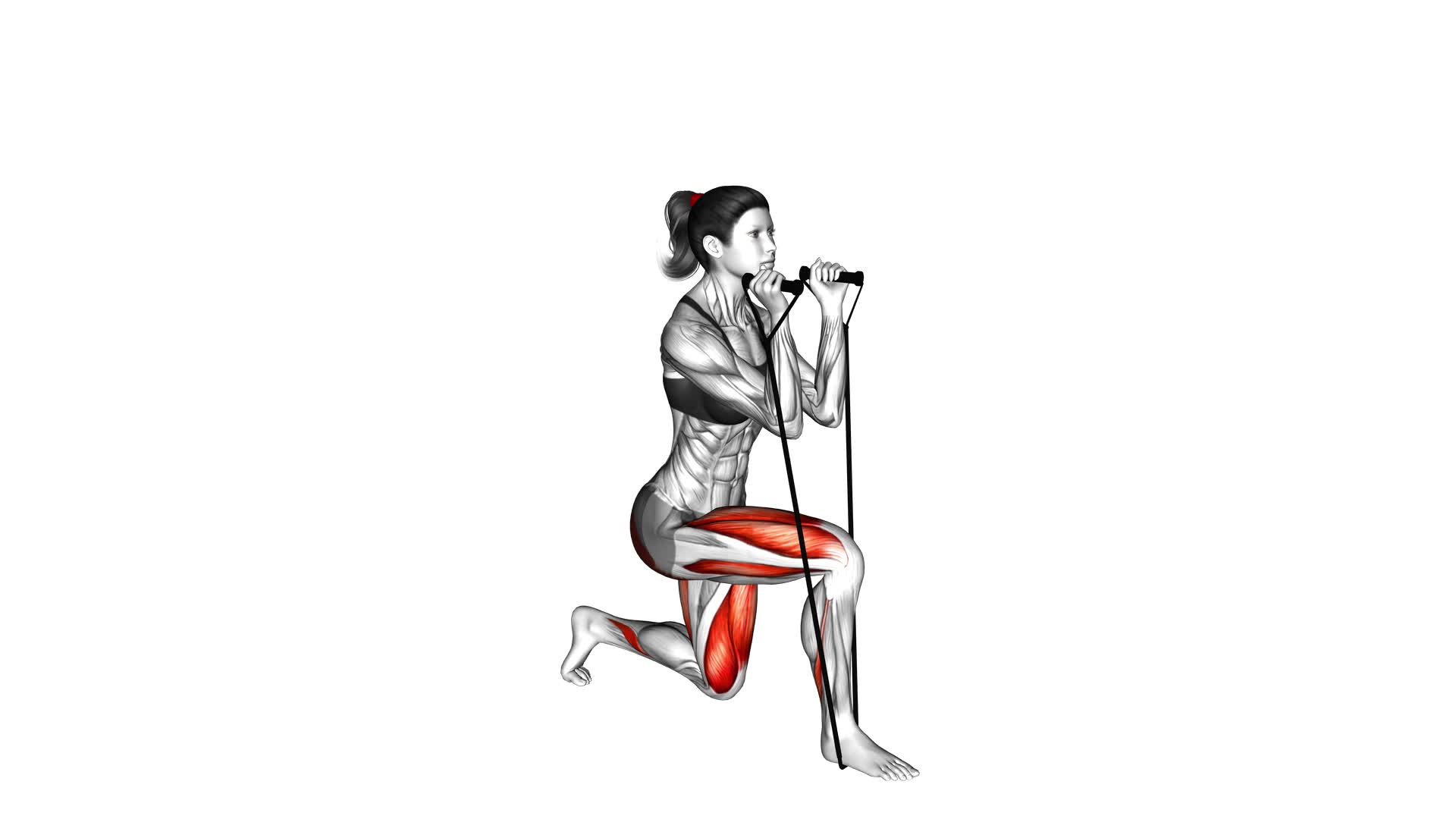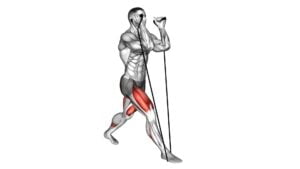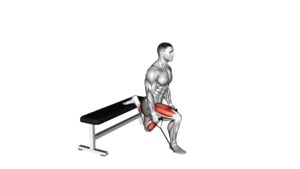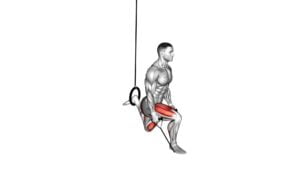Band Split Squat (female) – Video Exercise Guide & Tips

Looking to improve your lower body strength and tone your legs? Then the Band Split Squat is the exercise for you.
Watch This Exercise Video
In this video exercise guide, we'll show you the proper form and technique for this effective workout.
You'll also learn variations and modifications to challenge yourself and avoid common mistakes.
Get ready to enhance your workout routine with the Band Split Squat!
Key Takeaways
- The Band Split Squat is highly effective in improving lower body strength.
- It increases stability and enhances balance.
- The exercise adds resistance to target specific muscle groups.
- It builds strong leg muscles and increases power.
Benefits of the Band Split Squat
To maximize your workout, the band split squat offers numerous benefits for strengthening your lower body. This exercise is highly effective in improving lower body strength, increasing stability, and enhancing balance. By incorporating the band into the split squat, you add resistance that targets specific muscle groups, making it more challenging and yielding greater results.
The band split squat primarily targets the muscles in your lower body, including your quadriceps, hamstrings, glutes, and calves. As you lower into the squat position, the band provides resistance that engages these muscles, forcing them to work harder and become stronger over time. This exercise is particularly beneficial for individuals looking to build strong leg muscles, increase power, and enhance athletic performance.
In addition to improving lower body strength, the band split squat also helps to increase stability and balance. By performing the exercise on one leg at a time, you challenge your body's ability to maintain stability and control. This translates to improved balance not only during the exercise but also in daily activities and sports.
Incorporating the band split squat into your workout routine can have significant benefits for your lower body strength, stability, and balance. Remember to start with lighter resistance bands and gradually increase the intensity as you become more comfortable and confident in your ability.
Proper Form and Technique for the Band Split Squat
To perform the band split squat with proper form and technique, you should frequently engage your core and maintain a stable and balanced position throughout the exercise. This exercise is great for improving balance and increasing leg strength.
To begin, start by placing a resistance band around your ankles. Stand with your feet shoulder-width apart and take a step forward with one foot, keeping your back heel off the ground. Your front foot should be far enough forward so that when you lower down into the squat, your knee is directly above your ankle.
As you lower down into the squat, make sure to keep your chest lifted and your back straight. Engage your core to maintain stability and balance. Your back knee should come close to the ground, but not touch it.
Push through your front heel to come back up to the starting position and repeat on the other side. Remember to keep your core engaged and maintain a stable and balanced position throughout the exercise.
Variations and Modifications for the Band Split Squat
For variations and modifications of the band split squat, you can incorporate different resistance bands or adjust the range of motion to challenge your leg muscles and further improve your balance and stability.
To add resistance and increase the difficulty of the exercise, you can use a heavier resistance band or multiple bands. This will engage your muscles more and help you progress in your strength training.
On the other hand, if you want to focus on improving your balance and stability, you can decrease the range of motion by not lowering your back knee as far down. This will require more control and stability in your standing leg. Additionally, you can also try elevating your back foot on a step or box to further challenge your leg muscles. This modification will increase the demand on your front leg and require more strength and stability.
Remember to always choose a variation that suits your fitness level and goals.
As for equipment needed, a resistance band and a step or box are optional for these variations and modifications of the band split squat.
Common Mistakes to Avoid During the Band Split Squat
To perform the band split squat correctly, ensure that you maintain proper form and avoid these common mistakes:
- Leaning too far forward: One of the most common mistakes is leaning too far forward during the exercise. This not only puts excessive strain on your knees but also takes away the focus from your glutes and hamstrings. To improve, keep your chest upright, engage your core, and focus on pushing through the heel of your front foot.
- Not maintaining proper alignment: Another mistake isn't maintaining proper alignment throughout the movement. Your front knee should be directly above your ankle, and your back knee should be hovering just above the ground. Make sure to keep your hips square and avoid any lateral movement. This will help to engage the correct muscles and prevent injury.
- Neglecting proper breathing: Breathing is often overlooked during exercises, but it plays a vital role in maintaining stability and control. Many people hold their breath or take shallow breaths during the band split squat, which can lead to decreased performance and potential dizziness. Remember to inhale as you lower down and exhale as you push back up. This will help you maintain proper form and optimize your workout.
Tips to Enhance Your Band Split Squat Workout
Now let's explore some tips that can help you enhance your band split squat workout.
There are several ways to increase the intensity of your band split squat exercise.
First, you can try using a heavier resistance band or adding more tension to the band you're currently using. This will challenge your muscles even more and help you build strength and endurance.
Another option is to increase the number of repetitions or sets you perform. By doing more reps or sets, you'll be able to push your muscles to work harder and achieve better results.
Additionally, you can incorporate equipment options such as dumbbells or kettlebells to add resistance to your workout. Holding weights while performing the split squat will engage more muscles and make the exercise more challenging.
Lastly, you can try performing the split squat on an unstable surface, such as a balance board or BOSU ball. This will require more stability and core engagement, further enhancing the effectiveness of the exercise.
Remember to always listen to your body and progress at a pace that feels comfortable for you.
Frequently Asked Questions
How Many Sets and Repetitions Should I Do for the Band Split Squat?
To improve your form and get the most out of the band split squat, it's important to find the right balance between sets and repetitions.
Start with 2-3 sets of 10-12 repetitions on each leg.
As you become more comfortable and stronger, you can gradually increase the number of sets and repetitions.
Remember to listen to your body and make any necessary variations or modifications to suit your fitness level and goals.
Can the Band Split Squat Help With Improving Balance?
Yes, the band split squat can help improve your balance. By performing this exercise, you're engaging your core and lower body muscles, which in turn enhances stability. The unilateral nature of the split squat also contributes to balance improvement.
Additionally, the band adds resistance, making the exercise more challenging and further developing your stability. Incorporating band split squats into your workout routine can have numerous benefits, including improved balance and the advantages of unilateral training.
Is It Necessary to Use a Resistance Band for the Band Split Squat?
Using a resistance band for the band split squat can provide several benefits.
It adds resistance to the exercise, making it more challenging and effective for strengthening your lower body muscles.
The band also helps improve stability and balance by engaging your core and forcing you to maintain proper form.
Additionally, using different variations of the band split squat, such as adding a jump or a twist, can further enhance the workout and target different muscle groups.
Can the Band Split Squat Help With Strengthening the Core?
Yes, the band split squat can definitely help with strengthening your core. By incorporating a resistance band into the split squat exercise, you aren't only targeting your lower body muscles but also engaging your core muscles to maintain stability and balance.
This unilateral exercise has the added benefit of improving stability and coordination, which is essential for any fitness routine.
Are There Any Specific Warm-Up Exercises Recommended Before Performing the Band Split Squat?
Before performing the band split squat, it's important to warm up your body with specific exercises. By doing so, you can prepare your muscles and joints for the movement and reduce the risk of injury.
Some recommended warm-up exercises include leg swings, lunges, and hip rotations. These exercises can help increase blood flow, improve flexibility, and activate the muscles that will be involved in the band split squat.
Incorporating a proper warm-up routine will enhance the benefits of the band split squat and optimize your workout.
Conclusion
In conclusion, the band split squat is a highly effective exercise for women that offers numerous benefits, including improved lower body strength, stability, and flexibility.
By following proper form and technique, variations and modifications, and avoiding common mistakes, you can maximize the effectiveness of this exercise.
Additionally, incorporating tips to enhance your band split squat workout will help you achieve your fitness goals and see great results.
So grab a resistance band and start incorporating this exercise into your routine for a stronger and more toned lower body.

Author
Years ago, the spark of my life’s passion ignited in my mind the moment I stepped into the local gym for the first time. The inaugural bead of perspiration, the initial endeavor, the very first surge of endorphins, and a sense of pride that washed over me post-workout marked the beginning of my deep-seated interest in strength sports, fitness, and sports nutrition. This very curiosity blossomed rapidly into a profound fascination, propelling me to earn a Master’s degree in Physical Education from the Academy of Physical Education in Krakow, followed by a Sports Manager diploma from the Jagiellonian University. My journey of growth led me to gain more specialized qualifications, such as being a certified personal trainer with a focus on sports dietetics, a lifeguard, and an instructor for wellness and corrective gymnastics. Theoretical knowledge paired seamlessly with practical experience, reinforcing my belief that the transformation of individuals under my guidance was also a reflection of my personal growth. This belief holds true even today. Each day, I strive to push the boundaries and explore new realms. These realms gently elevate me to greater heights. The unique combination of passion for my field and the continuous quest for growth fuels my drive to break new ground.







